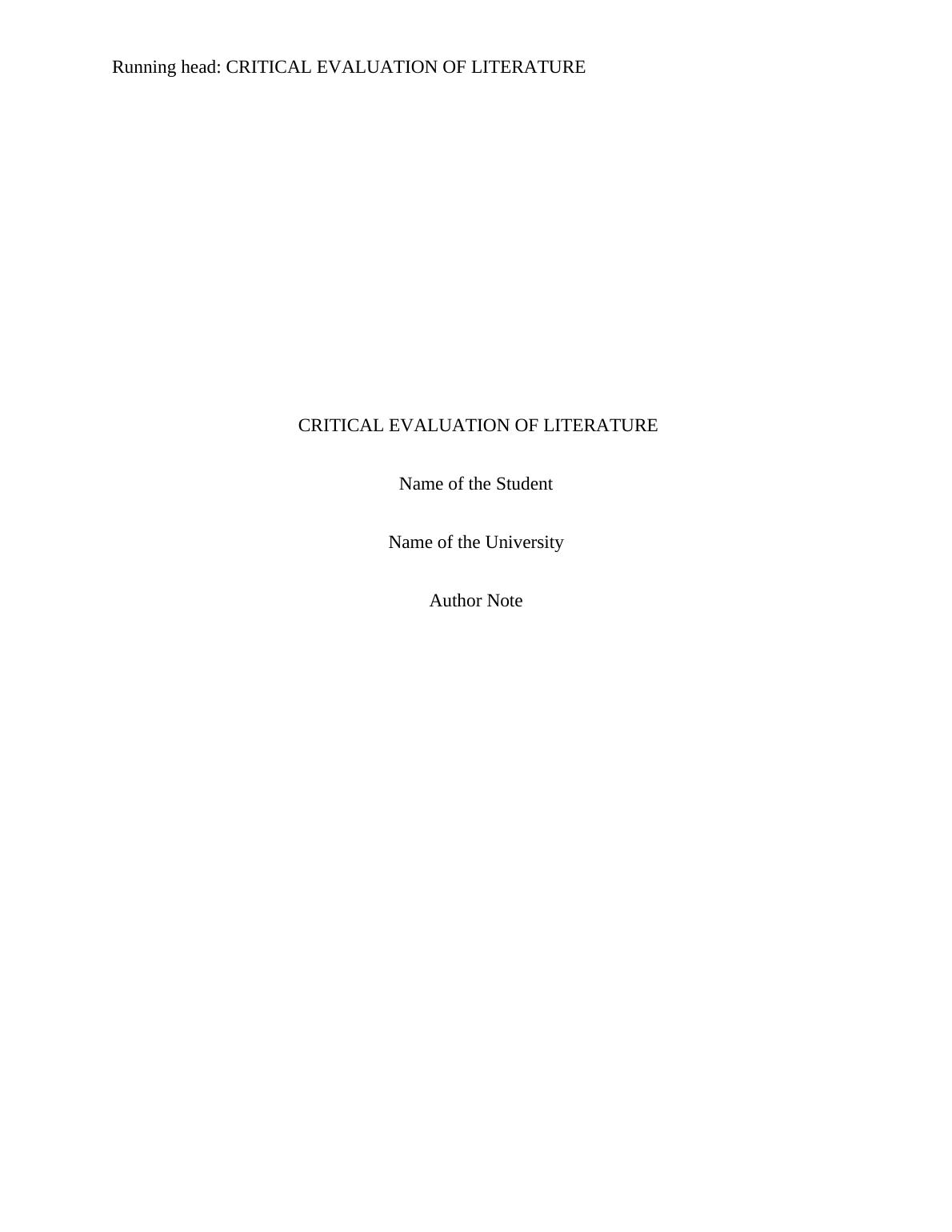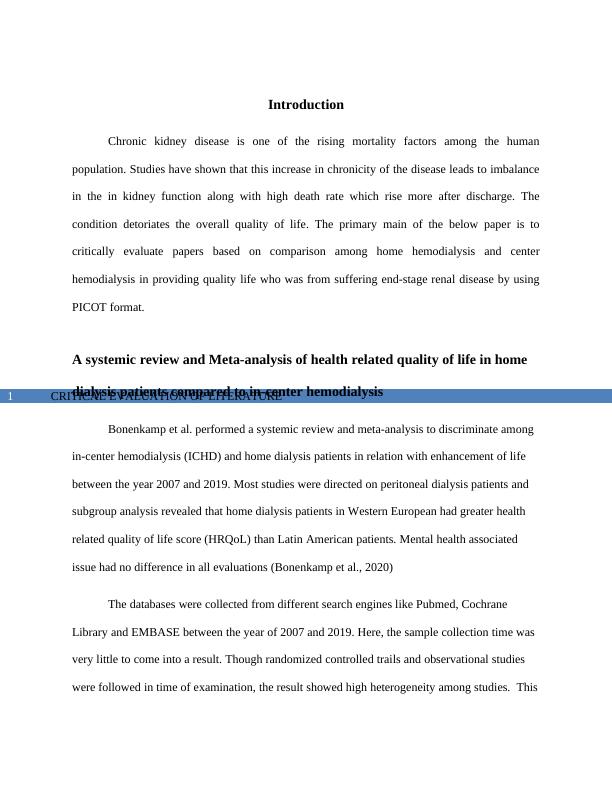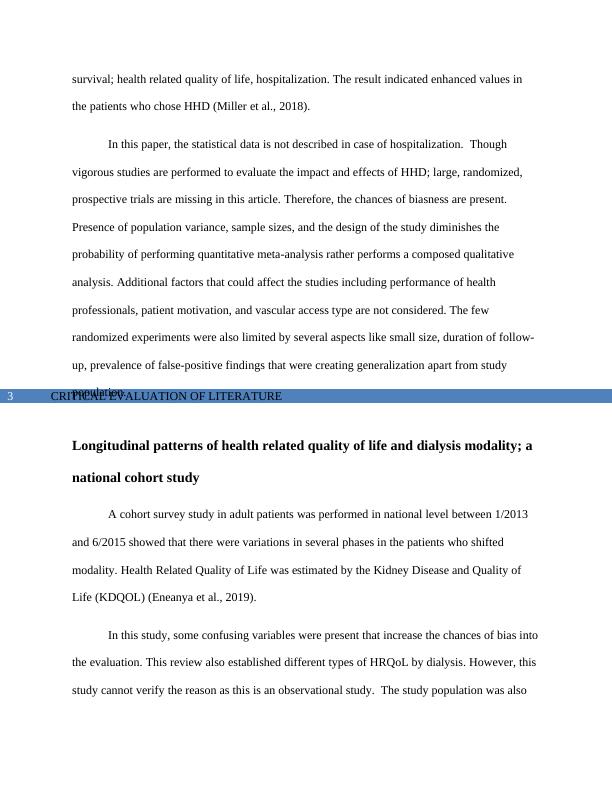Critical Evaluation Of Litrature
Added on 2022-08-16
12 Pages2855 Words21 Views
Running head: CRITICAL EVALUATION OF LITERATURE
CRITICAL EVALUATION OF LITERATURE
Name of the Student
Name of the University
Author Note
CRITICAL EVALUATION OF LITERATURE
Name of the Student
Name of the University
Author Note

CRITICAL EVALUATION OF LITERATURE1
Introduction
Chronic kidney disease is one of the rising mortality factors among the human
population. Studies have shown that this increase in chronicity of the disease leads to imbalance
in the in kidney function along with high death rate which rise more after discharge. The
condition detoriates the overall quality of life. The primary main of the below paper is to
critically evaluate papers based on comparison among home hemodialysis and center
hemodialysis in providing quality life who was from suffering end-stage renal disease by using
PICOT format.
A systemic review and Meta-analysis of health related quality of life in home
dialysis patients compared to in-center hemodialysis
Bonenkamp et al. performed a systemic review and meta-analysis to discriminate among
in-center hemodialysis (ICHD) and home dialysis patients in relation with enhancement of life
between the year 2007 and 2019. Most studies were directed on peritoneal dialysis patients and
subgroup analysis revealed that home dialysis patients in Western European had greater health
related quality of life score (HRQoL) than Latin American patients. Mental health associated
issue had no difference in all evaluations (Bonenkamp et al., 2020)
The databases were collected from different search engines like Pubmed, Cochrane
Library and EMBASE between the year of 2007 and 2019. Here, the sample collection time was
very little to come into a result. Though randomized controlled trails and observational studies
were followed in time of examination, the result showed high heterogeneity among studies. This
Introduction
Chronic kidney disease is one of the rising mortality factors among the human
population. Studies have shown that this increase in chronicity of the disease leads to imbalance
in the in kidney function along with high death rate which rise more after discharge. The
condition detoriates the overall quality of life. The primary main of the below paper is to
critically evaluate papers based on comparison among home hemodialysis and center
hemodialysis in providing quality life who was from suffering end-stage renal disease by using
PICOT format.
A systemic review and Meta-analysis of health related quality of life in home
dialysis patients compared to in-center hemodialysis
Bonenkamp et al. performed a systemic review and meta-analysis to discriminate among
in-center hemodialysis (ICHD) and home dialysis patients in relation with enhancement of life
between the year 2007 and 2019. Most studies were directed on peritoneal dialysis patients and
subgroup analysis revealed that home dialysis patients in Western European had greater health
related quality of life score (HRQoL) than Latin American patients. Mental health associated
issue had no difference in all evaluations (Bonenkamp et al., 2020)
The databases were collected from different search engines like Pubmed, Cochrane
Library and EMBASE between the year of 2007 and 2019. Here, the sample collection time was
very little to come into a result. Though randomized controlled trails and observational studies
were followed in time of examination, the result showed high heterogeneity among studies. This

CRITICAL EVALUATION OF LITERATURE2
study revealed ordinary to high risk of bias. The quality of study design was poor. For some
studies it was completely unknown in the interview that if any service providers were proficient
to evaluate HRQol . It hints to potential bias in outcome evaluation.
Patients receiving frequent hemodialysis have better health-related quality of
care patients receiving conventional hemodialysis:
Garg et al. completed two types of medical trial to evaluate the effect of frequent
hemodialysis in association with traditional method. The Regular trial arbitrarily allotted 245
patients to obtain both the aspect of frequent and conventional strategies. The nocturnal trial
randomly assigned 87 patients with the same criteria. The outcome was measured by the
differences in the treatment groups in one-year change in HRQol and evaluated by the method of
linear-mixed effects replicas. In center-dialysis facility offered better HRQoL with regular in
relation with conventional hemodialysis (Garg et al., 2017).
The study design with additional and elimination criteria of both the trials were correctly
discussed by the method of randomization process, data collection methods, and baseline
characteristics. Since the patients for both the nocturnal and daily trial were assigned randomly,
the biasness of the results was avoided.
Choosing home hemodialysis: a critical review of patient outcomes
A systemic review was performed by applying different databases like PubMed,
Cochrane Library to compare the result of Home hemodialysis (HHD) and ICHD in terms of
study revealed ordinary to high risk of bias. The quality of study design was poor. For some
studies it was completely unknown in the interview that if any service providers were proficient
to evaluate HRQol . It hints to potential bias in outcome evaluation.
Patients receiving frequent hemodialysis have better health-related quality of
care patients receiving conventional hemodialysis:
Garg et al. completed two types of medical trial to evaluate the effect of frequent
hemodialysis in association with traditional method. The Regular trial arbitrarily allotted 245
patients to obtain both the aspect of frequent and conventional strategies. The nocturnal trial
randomly assigned 87 patients with the same criteria. The outcome was measured by the
differences in the treatment groups in one-year change in HRQol and evaluated by the method of
linear-mixed effects replicas. In center-dialysis facility offered better HRQoL with regular in
relation with conventional hemodialysis (Garg et al., 2017).
The study design with additional and elimination criteria of both the trials were correctly
discussed by the method of randomization process, data collection methods, and baseline
characteristics. Since the patients for both the nocturnal and daily trial were assigned randomly,
the biasness of the results was avoided.
Choosing home hemodialysis: a critical review of patient outcomes
A systemic review was performed by applying different databases like PubMed,
Cochrane Library to compare the result of Home hemodialysis (HHD) and ICHD in terms of

CRITICAL EVALUATION OF LITERATURE3
survival; health related quality of life, hospitalization. The result indicated enhanced values in
the patients who chose HHD (Miller et al., 2018).
In this paper, the statistical data is not described in case of hospitalization. Though
vigorous studies are performed to evaluate the impact and effects of HHD; large, randomized,
prospective trials are missing in this article. Therefore, the chances of biasness are present.
Presence of population variance, sample sizes, and the design of the study diminishes the
probability of performing quantitative meta-analysis rather performs a composed qualitative
analysis. Additional factors that could affect the studies including performance of health
professionals, patient motivation, and vascular access type are not considered. The few
randomized experiments were also limited by several aspects like small size, duration of follow-
up, prevalence of false-positive findings that were creating generalization apart from study
population.
Longitudinal patterns of health related quality of life and dialysis modality; a
national cohort study
A cohort survey study in adult patients was performed in national level between 1/2013
and 6/2015 showed that there were variations in several phases in the patients who shifted
modality. Health Related Quality of Life was estimated by the Kidney Disease and Quality of
Life (KDQOL) (Eneanya et al., 2019).
In this study, some confusing variables were present that increase the chances of bias into
the evaluation. This review also established different types of HRQoL by dialysis. However, this
study cannot verify the reason as this is an observational study. The study population was also
survival; health related quality of life, hospitalization. The result indicated enhanced values in
the patients who chose HHD (Miller et al., 2018).
In this paper, the statistical data is not described in case of hospitalization. Though
vigorous studies are performed to evaluate the impact and effects of HHD; large, randomized,
prospective trials are missing in this article. Therefore, the chances of biasness are present.
Presence of population variance, sample sizes, and the design of the study diminishes the
probability of performing quantitative meta-analysis rather performs a composed qualitative
analysis. Additional factors that could affect the studies including performance of health
professionals, patient motivation, and vascular access type are not considered. The few
randomized experiments were also limited by several aspects like small size, duration of follow-
up, prevalence of false-positive findings that were creating generalization apart from study
population.
Longitudinal patterns of health related quality of life and dialysis modality; a
national cohort study
A cohort survey study in adult patients was performed in national level between 1/2013
and 6/2015 showed that there were variations in several phases in the patients who shifted
modality. Health Related Quality of Life was estimated by the Kidney Disease and Quality of
Life (KDQOL) (Eneanya et al., 2019).
In this study, some confusing variables were present that increase the chances of bias into
the evaluation. This review also established different types of HRQoL by dialysis. However, this
study cannot verify the reason as this is an observational study. The study population was also

End of preview
Want to access all the pages? Upload your documents or become a member.
Related Documents
Health related quality of lifelg...
|4
|622
|40
Research Method - Chronic kidney diseaselg...
|6
|1148
|31
Scoping Literature Review Incorporating Critical Appraisal of Researchlg...
|14
|3988
|50
Understanding of illness Assignment PDFlg...
|10
|2886
|298
Chronic Kidney Disease: A Case Studylg...
|12
|3166
|494
